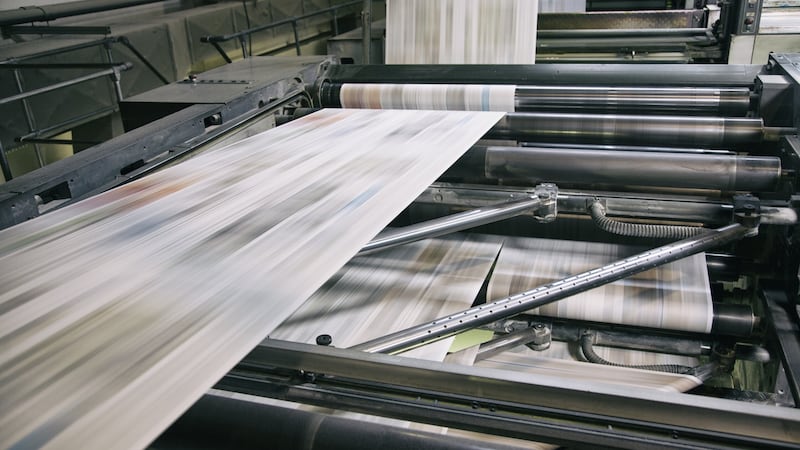In any discussion of the vinyl revival, the moment will come when someone mentions that, alas, there’s only one pressing plant of any scale left in the world; it’s somewhere in Germany, and it’s going to be fully occupied churning out pricey major-label reissues from now until 2037.
I exaggerate. Vinyl-pressing companies, ranging from the artisan to the obscure-but-industrial, operate all over Europe. But the point about low production capacity is true in essence. For all its fabled cut-through with younger generations, vinyl remains a specialist enterprise, still constrained by its own near-death, and hampered, too, by a physical music market that is a faint echo of its former self.
Between the collapse of vinyl sales in the mid-1980s and their recovery to, ahem, roughly where they were when they were dying 30 years ago, pressing plants fell silent, suppliers pivoted or went bust, jobs were lost and skills disappeared.

I was thinking about this gradual-then-sudden decline when it emerged last week that News Corp intends to close its printing plant in Kells, Co Meath with 59 expected redundancies.
The Rupert Murdoch-controlled publisher of the Sun and the Sunday Times has “regretfully concluded”, just a couple of months after acquiring control of the press and its operation (within a building and site that it already owned), that it wants to shut down the entire plant.
This is the "difficult conclusion" to a chapter that began at a markedly more optimistic time. Proposals by what was then News International and Smurfit International (now Smurfit Kappa) for a €50 million joint venture printing plant were first outlined to local councillors in 2000. Two years later, when the plant was opened by then taoiseach Bertie Ahern, it had swelled to a €64 million investment employing more than 100 people to print the Irish editions of Murdoch's papers: the Sun, the Times, the Sunday Times and the News of the World.
Ahern’s comments are truly from another age. Not only did he frame the opening as a reflection of “the historic opportunities which flow from the peace we enjoy thanks to the Good Friday Agreement”, he suggested Kells was moving into “the high technology printing world of the 21st century”. The proximity of the word “printing” to “world of the 21st century” was yet to seem in any way incongruous in the context of the news media.
Why would it? Irish newspaper sales were five years away from peaking. Now, to borrow a sporting phrase, it’s getting late early.
Printing retreat
Rationalisation of printing interests is in vogue. The once continent-spanning Independent News & Media (INM) empire spent the noughties consolidating smaller printing operations into its Belfast Telegraph city centre plant, which also picked up third-party contracts from Murdoch and others. In 2015, Belfast closed with the loss of 89 jobs.
In 2019, INM's new owners, Belgian group Mediahuis, announced the closure of the Citywest facility in Dublin that INM had opened 19 years earlier. Mediahuis, which had also inherited a newer printing plant in Newry, no longer needed two on the same island.
In the end, Citywest was bought by Webprint, the independent Cork company with a plant in Mahon and ambitions to be the last Irish printer standing. The Irish Times, meanwhile, prints its own newspapers and runs a contract printing business from its plant, also at Citywest and established the same year as News Corp's Kells venture.
The Kells shutdown will have "no impact" on the future of its newspapers, the printing of which will now be outsourced elsewhere in Ireland, News Corp stressed. Its contracts to print other publishers' titles, including the Irish Daily Mail and locally sold copies of the Financial Times, are also there to be mopped up by the remaining players in the game.
It is, nevertheless, the shrinking of newspaper sales that has prompted publishers to review their assets in the first place. As Mediahuis Ireland chief executive Marc Vangeel told business website The Currency, it had to avoid being saddled with "a big legacy problem". He likened such a problem to a stone in its shoe.
On the margins, print can still survive the ubiquity of digital, of course. Maybe, one day, it will even enjoy the sort of sustained upticks recorded by its younger cousin, the vinyl trade.
Sure, the revival of vinyl may be romanticised – the phrase “coming from a low base” has never been more apposite – but it is real. At some point, its trajectory may become an enviable one.
Indeed, vinyl’s ability to command ever-higher prices, while also escaping the brunt of environmental concerns – vinyl is plastic, after all – is extremely interesting.
Production complications
That the complications of vinyl production are still being reported on, long after the glory days of the market, is instructive.
A devastating fire at the Apollo Masters Corporation in California last year has left just a single manufacturer of the lacquer discs needed to assemble master plates for pressing records. This, together with a PVC shortage, has spurred supply-chain havoc. If independent artists find it impossible to get vinyl made, the format could be condemned to a nostalgia-only affair, bringing the revival to a shuddering halt.
But vinyl, for now, is thriving within its self-image as the choice of the music connoisseur. Its tangibility is its virtue, its awkwardness and expense part of the appeal. Could this consumer psychology be mined in the news business to profitable effect? Could printed newspapers – obliged to contend with their own surging input costs and shifting distribution logistics – some day achieve the same status as vinyl?
It seems more likely to me that niche magazine titles will be the ones to make similar, and similarly convincing, claims to retro-cool. Some already do. But even if the printed news sector struggles to manipulate the same consumer instincts that power vinyl, that doesn’t mean doing so won’t be worth a whirl.









